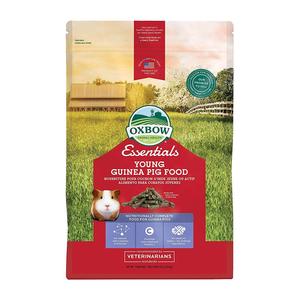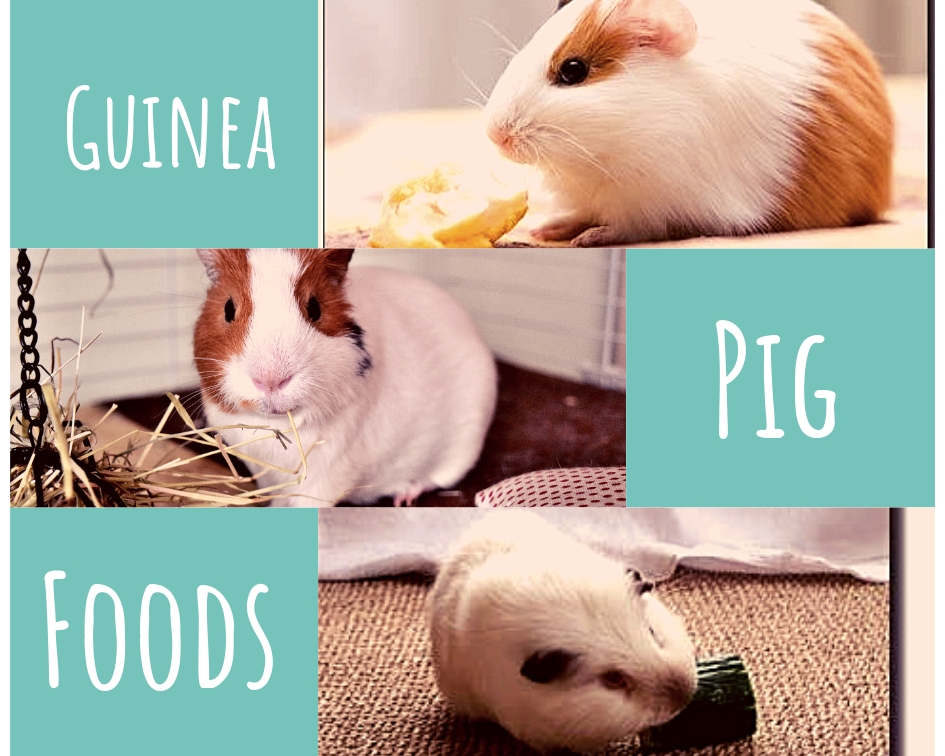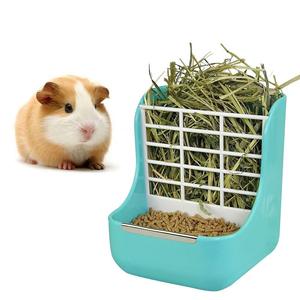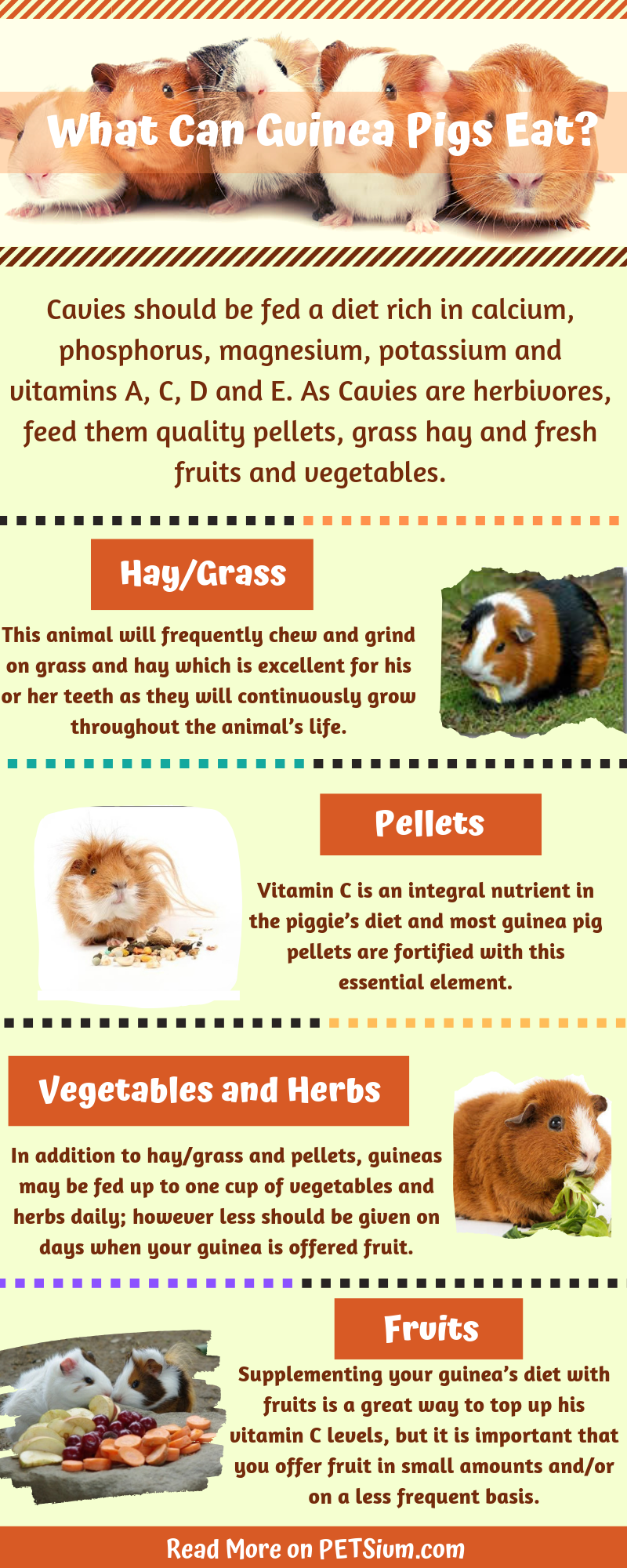If you have recently acquired a guinea pig or you are considering doing so, you are probably wondering the most common question among first-time piggie owners: what can guinea pigs eat?
It is not unusual for people to assume that because this species belongs to the rodent family that it can consume virtually anything and everything it comes across.
Guinea Pig Favorite Foods
Like most other creatures, this specie’s basic requirements are comprised of protein, vitamins, minerals, fiber, and a constant, fresh supply of water.
The sources from which these nutrients are obtained is key to a healthy and happy guinea pig pet.
In fact, some foods can be outright toxic to guinea pigs which is why it is extremely important that you understand which foods are safe to give to your pet and which ones should be avoided entirely.
RECOMMENDED PRODUCT

Guinea Pig Food Made with Timothy Hay by selective NATURALS
- Made with Timothy Hay to help promote the good health of guinea pigs.
- High in fiber and grain free, Selective respects the natural diet, that includes essential forage and garden vegetables.
- It supports digestive wellbeing and has all the vitamins and minerals that guinea pigs need.
- Contains Linseed for healthy skin and shiny coat.
Hay/Grass
Hay and grass should make up a significant percentage of the animal’s diet.
Not only does it provide the fiber that this little guy needs in order to have smooth, regular bowel movements, but hay will also create a delicate balance within the guinea pig digestive tract to ensure that it remains healthy and works effectively.
This animal will frequently chew and grind on grass and hay which is excellent for his or her teeth as they will continuously grow throughout the animal’s life.
Your rodent pet should have unlimited access to some sort of dry fiber; the type that you offer is up to you.
Consider offering your pet a selection of timothy hay and meadow grass as both of these items are well-loved by this species and provide all of the digestive support necessary for this pet.
You may decide to alternate between hay and grass on a regular basis, such as daily or weekly, or you could even offer a 50-50 mixture of grass and hay in order to provide your pet with a bit more variety.
Check his or her food a few times each day.
If the hay or grass becomes soiled or remains damp for an extended period of time, be sure to replace the old selection with a fresh, dry bunch.

Pellets
Even if you were to offer the animal a decent selection of hay, vegetables, and fruit, there is a good chance that your furry friend will be lacking in some essential vitamins and minerals.
It is difficult – even for experienced piggie owners – to provide exactly the right balance of dietary nutrition.
Because of this, pellets are considered to be the second most important element in the guinea pig diet.
Vitamin C is an integral nutrient in the guinea pig diet and most guinea pig pellets are fortified with this essential element.
Rodent pellets can be purchased at any pet supply store. In general, you should feed your guinea pig about one quarter cup of pellets each day.
If you supplement his or her diet with fresh vegetables each day, particularly ones high in vitamin C, you may lower the amount of pellets fed to your pet to one eighth cup.
Be sure to read the nutrition information and feeding guidelines on the pellet packaging to make sure that you aren’t overfeeding or underfeeding your piggie, as some store-bought products contain concentrated amounts of vitamins and minerals.
Pellets should be offered in a clean food dish, preferably one that is mounted to the cage to prevent spills.
RECOMMENDED PRODUCT

Essentials Young Guinea Pig Food by OXBOW
- Made with hand-selected Alfalfa hay.
- All-natural with vitamins and minerals.
- Fortified with stabilized Vitamin C.
- No seeds or fruits – No artificial ingredients.
Vegetables and Herbs
Fresh vegetables should be offered to your guinea pig periodically, but ideally your little friend will be able to enjoy a few pieces of vegetables each day.
In addition to hay/grass and pellets, guineas may be fed up to one cup of vegetables and herbs daily.
However less should be given on days when your guinea is offered fruit.
Bell peppers, kale, broccoli, turnip greens, and spinach are very high in vitamin C and may be offered to your guinea pig regularly.
When preparing bell peppers for your pet, be sure to remove all of the seeds from the pepper.

Never give this animal chili peppers, jalapenos, or other spicy peppers. Asparagus, cabbage, carrots, parsnips, turnips, cucumbers, celery, yellow and green squash, peas in the pod, watercress/alfalfa, and Brussels sprouts are other safe and healthy vegetables for your guinea pig.
This type of animal also enjoys small amounts of herbs, especially when mixed with other vegetables.
Basil, cilantro, chicory, parsley, dill, lavender, and mint are a few examples of herbs that your furry friend can safely enjoy.
Fruits
Supplementing your guinea’s diet with fruits is a great way to top up his vitamin C levels, but it is important that you offer fruit in small amounts and/or on a less frequent basis.
A pinch of fruit each day isn’t going to harm your guinea but if you choose to offer a small selection of various fruits then try to do so no more than two to three times per week.
Papaya, kiwi, guava, and mango are very high in vitamin c and piggies tend to love them.
You may also provide an assortment of various berries such as strawberries, blackberries, blueberries, and raspberries.
Elderberries may also be given in small amounts.
Apples (without the seeds), apricot, peaches, pears, and plums are cheap and abundant fruits that can be included in this animal’s diet.
Watermelon and honeydew may also be given although it is best to remove the rind first.
Find out can guinea pigs eat apples?
What Vegetables do Guinea Pigs Eat?
• Artichoke
• Arugula
• Asparagus
• Basil
• Beetroot
• Belgian Endive
• Bell Pepper (Remove Seeds)
• Broccoli
• Butterhead Lettuce
• Carrot Greens
• Carrots
• Cauliflower
• Celery
• Chicory Greens
• Chinese Cabbage
• Cilantro
• Coriander
• Corn Husks
• Corn Silks
• Cucumber
• Curly Endive
• Dill
• Escarole
• Grass
• Green Leaf Lettuce
• Green Leek Tops
• Kale
• Parsley Greens
• Parsley Root
• Pumpkin (Remove Seeds)
• Radicchio
• Red Leaf Lettuce
• Romaine Lettuce
• Rutabaga
• Spinach
• Sweet Potato
• Swiss Chard
• Thyme
• Tomato (Remove Seeds and Green top)
• Turnip Greens
• Watercress
• Zucchini
What Fruits do Guinea Pigs Eat?
• Apple (No Seeds)
• Apricot
• Banana
• Blackberries
• Blueberries
• Cantaloupe
• Cherries (Remove Pits)
• Cranberries
• Dates
• Figs
• Grapefruit
• Grapes
• Kiwi
• Mango
• Nectarine
• Oranges
• Peach
• Pear (No Seeds)
• Plum
• Raisins
• Raspberries
• Strawberries
• Watermelon
What Should Never Feed Guinea Pig?
• Alcohol
• Avocado
• Baked Goods
• Beans (Green Beans are Ok)
• Bok Choy
• Bread
• Carbonated Drinks
• Chocolate
• Coconut
• Coffee
• Collard Greens
• Corn
• Dairy
• Eggs
• Fish
• Fruit Juice
• Garlic
• Horseradish
• Hot Peppers
• Jam
• Lentils
• Meat
• Mushrooms
• Nuts
• Peanut Butter
• Pickled vegetables
• Potatoes
• Processed Foods
• Rhubarb
• Seeds
• Taro
• Tea
• Tomato Leaves
What do Guinea Pigs Drink?
Guinea pigs need a constant fresh supply of plain water in order for them to be happy. Here are a few tips on watering your guinea pig.
• Untreated tap water is not recommended. It can contain chlorine and heavy metals such as iron, which can harm your furry friend.
• Distilled water does not provide any minerals and thus should be avoided.
• Conversely, water that is high in minerals such as calcium should be avoided.
• Bottled water or water that has been filtered from the tap are the best options.
• Use a chew proof water bottle and clean the nozzle regularly.
If you follow these guidelines your cavy will stay happy and hydrated!

Foods Never to be Given to Guinea Pigs
Some foods are prone to causing digestive upset, stomach ulcers, or even outright toxicity in this species. Some foods, such as pineapple, citrus fruits, beets, cherries (without the pit), eggplant, leeks, radish, and sweet potato may be fed to rodent pets on a rare basis – meaning no more than once a month.
You should never feed fruit pits, apple seeds, potatoes, or potato vegetation to this type of rodent as they can be toxic and even deadly.
Rhubarb, rhubarb leaves, and tomato leaves are also unsafe for piggies to consume.
Obviously you should never feed your fuzzy companion foods that are in any state other than fresh (meaning cooked, pickled, or tinned).
Nuts, seeds, beans, lentils, corn, dairy products, eggs, and meat should also never be offered.
Being a responsible pet owner means doing the appropriate research necessary to gain a solid understanding of what you can and cannot offer the guinea pig.
The sections above contain detailed lists of foods that should be given regularly, in moderation, rarely, and not at all.
However if you come across a food not included in this article that you would like to offer your fuzzy family member, the best course of action would be to call your veterinarian to determine whether the food is safe for this species.
RECOMMENDED PRODUCT

Food Bowl and Hay Rack for Guinea Pig by sxbest
- The feeder’s upper layer is a grass rack,and the lower layer is a food bowl.
- Made of antibacterial ABS material to ensure a non-toxic, durable, long-lasting feeder.
- The edge of the food bowl is reinforced with metal sheets to prevent your cavy from biting the bowl.
- The grass rack is removable so that you can easily clean it.
